Events and excursions, Summer 2011
ASHBOURNE - SUNDAY 22 MAY 2011 Wet and Dry in Ashbourne
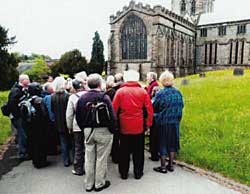
Alan talking about Ashbourne church.
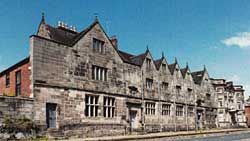
Ashbourne Grammar School.
The 38 members and friends who took this excursion were, in fact, fortunate with the weather which was blustery but required raised umbrellas only twice and then for short periods only.
We were very fortunate to have Adrian Henstock as leader for the day; Adrian was raised in Ashbourne and knows the town like the back of his hand.
On arrival we were provided with a welcome cup of tea/coffee with biscuits in the Parish Hall, where, once a slight confusion with a baptism party had been sorted out, Adrian gave an outline of the history of the town before the tour started with St. Oswald's Parish Church.
There is slight evidence for the existence of a Saxon church on this site and a priest and church with land is mentioned in Domesday but there is little remaining of the Norman church other than remains of a crypt under the south transept and fragments of stonework in the north-east corner of the nave. The present church was begun at the beginning of the thirteenth century and built in the Early English style, with the first part to be completed being the chancel which was dedicated by Bishop Hugh de Patishul in 1241. We were unable to see the commemorative plaque because of building work inside the church. However, the plaque is the oldest such plate in England and probably the second oldest in Europe. William Rufus had given the church to the Dean and Chapter of Lincoln Cathedral in 1093. The nave and tower were completed in the late thirteenth century. The most impressive spire was added early in the fourteenth century and stands at 212 feet and weighs over 300 tons which has caused maintenance problems in the church over the years.
Ashbourne was a prosperous town due to Peak District lead and sheep, the church reflects the wealth of the parish. In 1698 the church suffered storm damage necessitating removing and rebuilding some twelve feet of the spire and associated roof repairs which took five years to complete.
In 1760 a gallery was added adjacent to the north wall of the nave over an existing gallery known as the 'Scholar's Loft' but, and despite the ongoing prosperity of the town, the church appears to have fallen into some disrepair. In 1838 a new curate described the building as 'cold and damp, and decayed and deformed'. Apparently several windows in the chancel were blocked-in and urgent repairs costing £5,000 were completed and the church reopened in 1840. Stained glass windows were added which caused John Ruskin to complain to the vicar that the new glass on the north side of the chancel was 'the worst piece of base Birmingham manufacture I have ever seen'.
Sir Gilbert Scott undertook restoration work in the late nineteenth century which involved changing the chancel roof line and adding crenellations as seen today.
The first organ was fitted in 1710 made by Valentine of Leicester but this was replaced in 1858 by the Reverend J. R. Errington with another made by William Hill of London.
The interior of the church is impressive and in the Boothby Chapel are fine alabaster effigies of several important people from the parish, members of the Cockayne, Bradbourne and Boothby families
Adrian amused us by recounting the battle the Reverend Errington had to install his own organist, Bernard Parkin. The previous organist, Andrew Loder, refused to give up his post which resulted in difficulties for some time before Loder eventually ceased his resistance and emigrated to Australia.
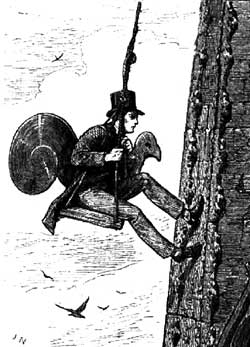
Another amusing incident recounted by Adrian involved the weather-cock on the church spire. In 1873 it required replacing and the then vicar, Reverend Edward Moore, climbed the spire and replaced it himself; this gave rise to an amusing cartoon showing his action. This bird was affectionately known to local children as 'Charlie-Chuck-Chuck'.
After leaving the church we walked along Church street towards the Market Place, stopping frequently to admire the Georgian buildings and listen to Adrian's explanation of the style and his contemporary quotations about the families who occupied the properties. Not to be missed is the Elizabethan Grammar School building which is very close to the church, even now, divided as it is into three separate units, it is a most impressive building.
As we walked along Church Street, we were shown Adrian's family home together with his Grandparents' house.
Our walk was greatly enhanced by Adrian's meticulously researched information, delivered in an inimitably amusing style which maintained our interest at all times.
The day finished back in the Parish Hall with an excellent tea, as is the tradition on Thoroton excursions.
Howard Fisher
ILKESTON, BEAUVALE and GREASLEY SATURDAY 11 JUNE 2011
The leaders for this excursion were Derek and Ceri Little.
The excursion revolved around the historical connection of sites associated with the de Canteloupe family, their manors, their church foundations and the priory which they founded.
After coffee in the Cantelupe Centre attached to St. Mary's church in Ilkeston, we enjoyed a talk by a member of the church and had plenty of time to look around this large and well endowed building. The amazing fact is that in the nineteenth century it was decided to extend the church, and the nave was doubled in size and the tower rebuilt stone by stone at the new west end. Two hours in the town gave a chance to visit a well run museum and to witness an annual carnival procession.
The visit to the site of Beauvale Priory was like stepping back in time to when the Carthusian monks found the beautiful valley where they could follow their silent order, disturbed only by the song of the birds and the presence of sheep. We meditated before the modern memorial to prior Lawrence and prior
Houghton who were executed in 1534 for refusing to acknowledge Henry Vlll's authority over the church in England. What the present owners have achieved in only five years is a real work of dedication and energy: not only have they gained the full support of English Heritage to restore the parts of the building which remain, but they have also created detailed plans for the future development of tea rooms and an education space for school and other parties.
After a splendid tea (not monk's fare!) we travelled to Greasley church, originally associated with the de Cantelupes who occupied Greasley castle. Another interesting talk and tour explained that coal mining in the nineteenth century had caused the chancel and tower of the church to break away from the nave, a disaster which led to a major restoration and virtual rebuilding in 1896. Only parts of the outside walls of the chancel are original stonework now.
Our thanks to Derek and Ceri Little for their excellent organisation of the day.
Alan Langton
SCAMPSTON HALL AND BIRDSALL HOUSE, THURSDAY 14 JULY 2011
We may well ask what the connection is between a famous hall in Nottinghamshire and two properties near to the Yorkshire town of Malton. The answer lies in the Willoughbys of Wollaton.
The outing of the Society on 14 July not only gave the forty members excellent tours of two historic houses, which today enjoy a close business relationship, but also gave us significant historical information to fill in the gaps about what had happened to the Willoughbys since they left Wollaton in 1729.
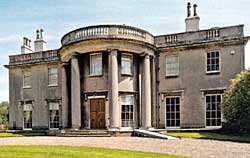 Scampston Hall, built in 1690 and remodeled 1795-80.
Scampston Hall, built in 1690 and remodeled 1795-80.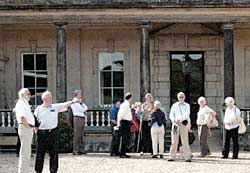
At Birdsall House.
Scampston is particularly famous for its walled garden of nine acres, designed by Piet Oudolf, a leader in the new European Movement. It also has a delightful family house, full of famous paintings (including works by Gainsborough) and antique items of china, which create a home that exudes warmth and welcome. We were given a full tour by Sir Charles Legard and his colleague before enjoying an appetizing lunch in the new visitor centre.
Our excursion continued to Birdsall House, set in most idyllic scenery, which on 14 July was bathed in splendid sunshine. Birdsall is not normally open to the general public, and members were struck by familiar scenes of Nottingham, the river Trent, and Wollaton Hall portrayed in pictures on the walls, revealing the connection between the family's former occupancy of Wollaton Hall and its present home in Yorkshire.
Again, members enjoyed excellent tours of all the rooms at Birdsall, conducted by the Honourable James and Lady Cara Middleton, where we saw items of art and antiques, reflecting the result of many years collecting by the Middleton family.
We were treated to tea and biscuits in the large family dining room before leaving for our journey home.
Alan Langton.
Ed. Alan is too modest to say in this report that he was the leader for this day which was superbly organised, including the excellent weather.